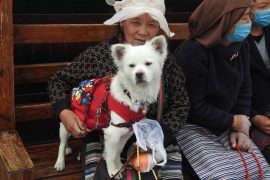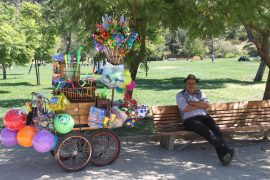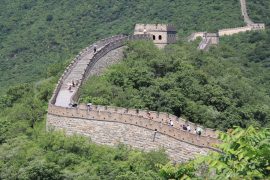IT’S not yet 6am and we are all quiet in that way you are before you are properly awake. When we get out of the small coach we can just make out the angular shapes of the young desert oak trees in the
inky darkness. As we walk up the narrow sandy track through the dunes someone makes a joke about how he hopes the snakes get an earlier start than humans and have already slithered off into the spinifex. An elderly English couple look slightly dubiously at the undergrowth.
Finally we arrive at the viewing platform and scan the pre-dawn sky. All around, people are gathering, setting up their cameras. There is an air of expectation. As the sky lightens, the vast iconic shape of Uluru emerges in the distance, suddenly dazzling as the rising
sun seems to transform the rock into something alive. In the  distance, to our left, Uluru’s bigger sister, Kata Tjuta is also waking, seamlessly transformed as the sunrise hits from iron grey, to dark purple to vibrant ochre. Watching the sun rise over Uluru is more than just an event to be ticked off the “bucket list” but is something that becomes imprinted on memory.
distance, to our left, Uluru’s bigger sister, Kata Tjuta is also waking, seamlessly transformed as the sunrise hits from iron grey, to dark purple to vibrant ochre. Watching the sun rise over Uluru is more than just an event to be ticked off the “bucket list” but is something that becomes imprinted on memory.
Most of the visitors sharing the experience are staying at the Ayers Rock Resort. It is like a small village that has separate living centres such as the top-of-the-market Sails in the Desert through to a camping ground but with a wide variety of gathering places where people can come together to eat, drink and be entertained. Great emphasis is placed on authentic and interesting cultural experiences, many of them free. Events such as the guided garden walk where an indigenous guide describes the native plants and their role as food or
medicine. There are bush yarns or displays of traditional weapons and tools, held several times a day in the Circle of Sand in the Town Square Lawn area. And every afternoon there is a fascinating hour- long show of Aboriginal song and dance by the Wakagetti Cultural dancers, also held in the Town Square Lawn area.
long show of Aboriginal song and dance by the Wakagetti Cultural dancers, also held in the Town Square Lawn area.
All my life I’ve tried to avoid audience-participation of any kind, but
just after halfway through, the inevitable occurred. First there were the men in the audience who were lured into the action. They jumped, squatted, scratched and lounged through the story of the kangaroo. Then it was the turn of the women, transformed from tourists into beady-eyed emus, clawing the ground, strutting and pecking. Despite the laughter they were surprisingly impressive. The applause told the full story of the battle of the sexes. Or perhaps that should be species. In the end it was unanimous. The emus took the
day.
There is a variety of guided tours to Uluru and Kata Tjuta that are
available from a range of operators including by camel, Harley- Davidson motorcycles and by helicopter. Under expert guidance the multiple layers of the ancient rock formations are revealed from the rock art to Aboriginal stories, as old as time, that are represented in the rock shapes; from the geological upheavals that resulted in such unique natural monuments to the medicinal powers of the native vegetation. While most skilfully elude visitors, there is plenty of native wildlife around leaving tell-tale signs (if you know where to look) in the red sand.
As we entered Walpa Gorge, a couple of wallabies watched our  progress, curious, then bounded away effortlessly when we moved too close. Tiny birds dart from hiding place to hiding place, so quick they are hard to follow. Birds of prey cruise the thermals, ever watchful for lunch.
progress, curious, then bounded away effortlessly when we moved too close. Tiny birds dart from hiding place to hiding place, so quick they are hard to follow. Birds of prey cruise the thermals, ever watchful for lunch.
By the time we get back to the resort, it has been a long day since we saw the sunrise, but Uluru has further treasures in store. There’s just time for a sumptuous wind-down at the Red Ochre Spa before re- grouping for another adventure. As the late afternoon shadows subtly transform the landscape we arrive at the bottom of a large dune and are ushered to a plateau that looks out on mesmerising
grouping for another adventure. As the late afternoon shadows subtly transform the landscape we arrive at the bottom of a large dune and are ushered to a plateau that looks out on mesmerising
views. The setting sun has thrown a deep red veil across the earth and long shadows are creeping across the landscape. Sipping champagne, and with the sound of a didgeridoo playing,  we watch as the last rays play on Uluru before disappearing. The sun may have gone but the night is just beginning. We are led
we watch as the last rays play on Uluru before disappearing. The sun may have gone but the night is just beginning. We are led
down the soft sand track to our tables, laid for fine dining under the stars. This is the Sound of Silence. A lavish buffet has been set out, drawing heavily on local produce, and there is endless wine and cold beer. Depending on the weather the resident astronomer will take diners on a journey through the heavens as they eat. This night, storm clouds are gathering and the stars just occasionally peek from between them. A lot of imagination, and the feeling of being part of something very special, meant that no one cared. As well as these large groups, the organisers are happy to arrange pretty much anything that people would like to enjoy. Like your own black-tie dinner arriving by camel? An Arabian Night where you relax on carpets and plump cushions, eat, drink and dance? There is even a Priscilla Queen of the Desert evening close to the area where the hilarious movie was shot.
About $30 million has been spent renovating Sails in the Desert and creating the Uluru Meeting Place, a large convention centre targeting the growing international conference and convention market. Fascinating indigenous art and art-inspired fittings are evident throughout the building. The elegant lobby carpet is taken directly from a huge work by artist Sandy Willie. And a dynamic sculpture, celebrating the Minyma Kuniya story of creation dominates the bar. Inside each room there is an original punu (a small wood carving) made by the local Anangu artists and a beautiful large cushion based on the Seven Sisters design by Nelly Patterson.
There are two main restaurants, the a la carte Mayu and the lively Ikari, which offers a series of signature dishes, many featuring indigenous flavours, accompanied by a wide selection of hot and cold dishes arranged buffet-style. There are also the less-formal eating and drinking areas dotted around the hotel and the wider village, from the poolside bar serving snacks, to the lively Geckos Cafe, to the very popular open barbecue area.
Visiting Uluru and Kata Tjuta is for most people a once-in-a-lifetime experience and it is easy to be overwhelmed by the unique beauty of the place. But what stays with you after you have left is something more ephemeral, a feeling that you have been briefly part of the seamless line between the past, the present and the future.







Comments are closed.